Both Kahle and circle hooks are alternatives to traditional J-hooks…but what’s the difference? And which style should you use?
I use both styles of hooks quite often when I’m out fishing, so in this article, I’m going to share with you everything I’ve learned over the years.
If you’re not using them yet, I bet you will after reading this!
Table of Contents
What’s The Difference Between Kahle Hooks vs Circle Hooks?
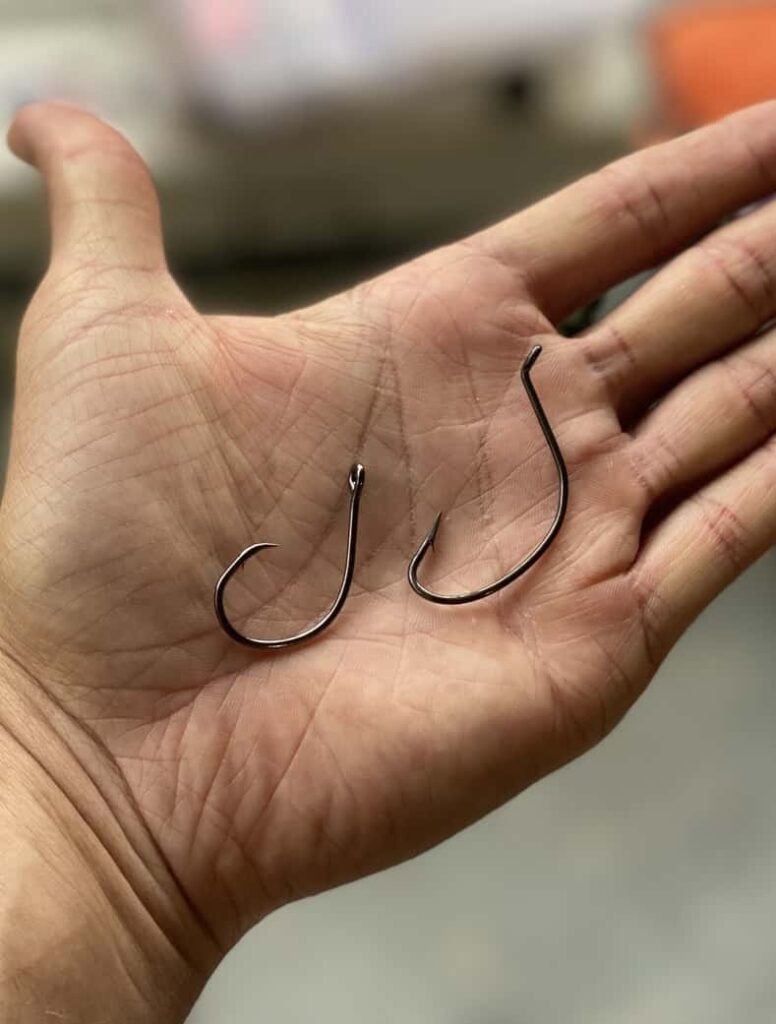
Kahle hooks and circle hooks are specifically designed for live bait or cut bait fishing. Circle hooks have an inward shaped point, and a short gap designed to prevent the fish from swallowing the hook. Kahle hooks have a standard point, but a very wide gap making them much easier to bait.
While the two styles of hooks were developed with similar purposes in mind, there are still a few differences between Kahle hooks vs circle hooks.
They are both an alternative to traditional J-hooks, and their unique shape limits the occurrence of ‘gut hooks‘, which is when a fishing hook gets stuck in a fish’s belly instead of its mouth (often killing the fish).
While this is not a problem if your keeping fish to eat, anglers practicing catch-and-release fishing want to avoid gut hooks because that almost certainly kills the fish and undermines the point of fishing conservation.
Plus depending on what you are fishing for, and where you are located some fish maybe catch and release only, or out of season.
See Also: The Definitive Guide To Hook Types, Styles, Shapes, and Sizes
Kahle Hooks
Description
A Kahle hook is somewhere in between a circle and a J-hook. It was developed by the prominent Eagle Claw company and is similar to a wide gap or shiner hook. Its commonly used with live bait such as shiners, fathead minnows, shrimp etc. It may also be used for cut bait or chunk bait, such as stink baits, clams, chicken gizzards, and many more.
Shape
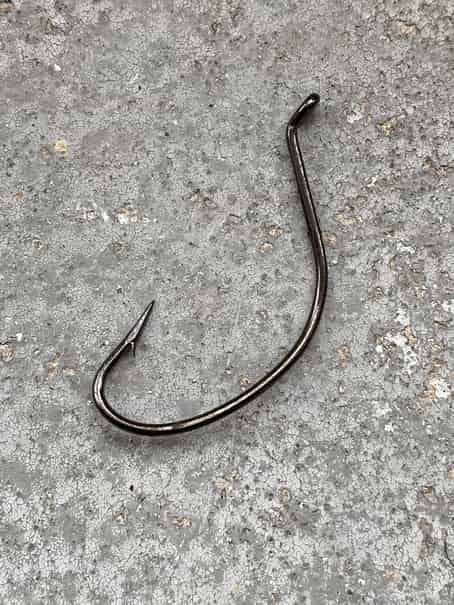
The point of the Kahle hook is not bent inward like a circle hook, but it curves back toward the eye, which is the part of the hook that connects to a fishing line.
The opening is wider than a J-hook but narrower than that of a circle hook. It also tends to be thinner in diameter than a circle hook and has an elongated bend.
Fishing Style
Kahle hooks are one of the most versatile hooks on the market, allowing you to either set the hook normally or ‘apply tension’ and let the hook auto-set itself. They have been around for a long time.
Kahle hooks are commonly used to catch speckled trout, flounder, and pompano in saltwater fishing and largemouth Bass (shiner fishing), catfish and carp in freshwater fishing.
How to use Kahle Hooks
Kahle hooks are easy to use because they are much easier to bait than a circle hook, and you can fish them in a variety of setups and styles.
Kahle hooks are more similar to traditional hooks than circle hooks, there is not much difference between how you would fish using one of those or a J-hook. You can choose to set the hook yourself or not, the hook will work either way.
When using a Kahle hook, one thing to remember is that the possibility of a gut hook is greater than with a circle hook, although it’s still lower than with a J-hook.
If you are planning on strictly catch-and-release fishing, avoid Kahle hooks to minimize the damage to the fish.
The Best Uses for Kahle Hooks
Kahle hooks are the better choice for more active fishing setups and when catch and release is not critical. It may also be preferred for certain species of live bait, such as wild shiners.
See Also: How To Catch Your Own Wild Shiners
Fishermen who prefer to set the hook themselves instead of deadsticking, or ‘set it and forget it’ should go for Kahle hooks over circle hooks.
Circle Hooks
Description
A circle hook has a point that gently bends inward toward the hook shaft. It has a wider curve than a J-hook or a Kahle hook. Circle hooks cause lower mortality rates among fish because they rarely get swallowed, and instead hook in the corner of the mouth.
Shape
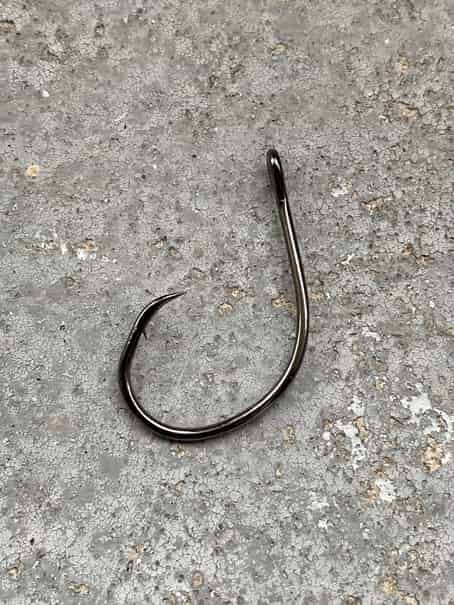
The circle hooks’ main feature is the inward bending point- or tip of the hook. This is designed to prevent the fish from swallowing the hook. It has a short gap and rounded bend.
Fishing Style
Circle hooks are best for times when feeling the bite may be difficult. Bottom fishing, live bait fishing, and deep sea fishing are great for circle hooks.
I love to use circle hooks when im using live bait to fish for snook, redfish, black drum, tarpon, grouper and snapper. In freshwater, I use circle hooks to fish for catfish, gar, and even bowfin!
Circle hooks are also great for beginners that may not know when to set the hook or understand how long to let a fish take your bait.
How to use Circle Hooks
One of the biggest adjustments that you need to make when using circle hooks is when you set the hook- YOU DONT!
Yes, that’s right. Do not set the hook! If you try to set the hook, you will pull the hook right out of the fish’s mouth.
The proper way to use a circle hook is to simply reel in your slackline in a steady retrieve, and allow the hook to set itself. The inward shaped point of a circle hook will catch the corner of the fish’s mouth when put under tension.
Once hooked, you fight the fish as normal! They really do work.
The Best Uses for Circle Hooks
Although circle hooks were initially used for commercial long-line fishing, they have since been introduced to saltwater billfish fishing and they are now common in freshwater fishing as well. Many catfish and carp anglers use them!
Circle hooks are the best for catch-and-release fishing because they cause the least damage to fish.
Circle hooks are also better for passive fishing setups, such as deadsticking, surf fishing, or deep sea bottom fishing.
In fact, in some states, if you are fishing for reef species circle hooks may be required!
Conclusion
If I am using any kind of live bait or cut bait, you can bet I’ll be using either a circle hook or a Kahle hook.
If I want to strictly catch and release fish, or if I am fishing areas with high current & deep water I’ll use a circle hook (such as live bait fishing for snook).
If I’m fishing in an area with the potential to keep fish, and I can really feel the bite I’ll use Kahle hooks (they’re my favorite type of hook to use when fishing with wild shiners).
The bottom line is both of these hooks are very effective and can increase your hook-up ratio if used properly. I hope this article helps you out, thanks for reading!
- Sauger vs Walleye: Learn These Differences and Catch More!
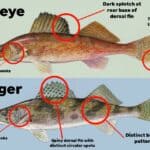
- How To Hold A Bluegill: Tips and Best Practices
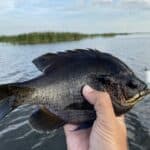
- How To Catch Wild Shiners For Bait (Step By Step W/Pics)
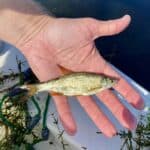
- Crazy Facts About the World Record Crappie

- What Size Hooks for Smallmouth Bass? Quick Guide

- Large and in Charge-Mouth: 10 of the Best Bass Lures of All Time (And Where to Buy Them)

Like this post? Save it on Pinterest.

